A lick alike. Peas in a pod. Carbon copies of each other. Whichever way a person chooses to phrase it, the Chevrolet Colorado and GMC Canyon are the same in a lot more ways than they are different. This isn’t news, with shared powertrains between the two midsize truck offerings from General Motors being a strategy that goes back decades.
But, as anyone with a twin – especially a fraternal twin – will tell you, similar genetic material does not always create the same personality. That is true of these two trucks as well. Where the Chevy likes to shout, the GMC is a bit more quiet. When the bowtie likes to go bash rocks off-road, its brother might prefer to wheel down to the lake’s edge for an evening’s fishing. Both are capable in all the ways that matter to truck buyers but choose to express that capability in vastly different ways.
The brothers have different sets of clothes in their closet as well. A Canyon Denali is this platform’s equivalent of donning a nice suit and heading out to a show. Compare that to a Colorado ZR2 Bison, which wears throws on its off-road jersey and chest protector before heading off on its dirt bike. Peas in a pod? Nah. These two are chalk and cheese.
ALSO SEE: 7 Differences Between the 2019 GMC Sierra and Chevrolet Silverado
We’ve done the heavy lifting of comparing these two trucks, a pair which may at first seem very similar but reveal distinct personalities once one peels away a few layers.
Chevy Colorado vs GMC Canyon
Powertrains
Chevy Colorado: Three engines are available in Chevy’s midsize pickup for 2019. Starting at the entry-level 2WD work truck, GM installs a 2.5L inline-four making 200 horsepower. Volume models are generally fitted with the 3.6L direct-injection V6, a mill that produces 308 horses. A torquey 2.8L four-pot turbodiesel is also available, making 186 ponies and 369 lb-ft of torque. Six- or eight speeds reside in the automatic transmission depending on engine size, while availability of a not-oft seen six-speed seems to be fluid.
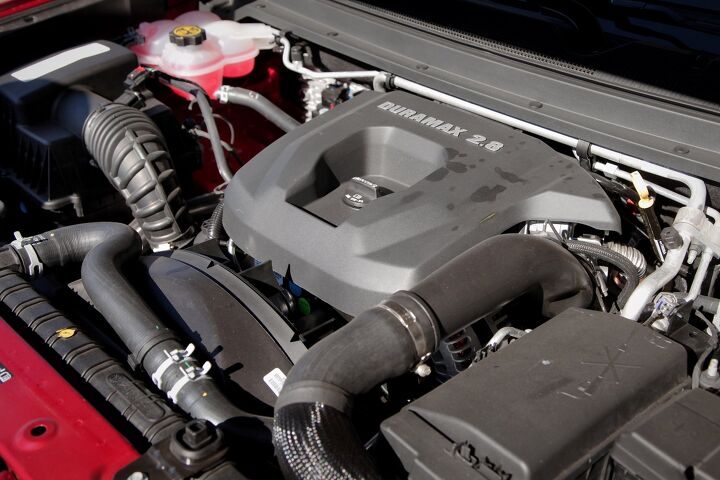
GMC Canyon: If you read the above paragraph, you’re already up to speed on the Canyon’s powertrain offerings. The gasoline V6’s torque rating is significantly less than the oil burning mill (275 lb-ft compared to 369 lb-ft, respectively) providing a vastly different driving experience If high-speed running is your bag, get the gasser. If you desire gobs of low-end grunt, pop for the diesel.
Bottom Line: In terms of engines and transmissions, both trucks are virtually indistinguishable. Selecting one over the other is like choosing between identical cans of peas at the supermarket.
Off-Road Swagger
Chevy Colorado: GM has decided to make the bowtie truck its standard bearer for off-road cred when marketing these fraternal twins. As an “off-road lite” option, the Z71 package adds a locking rear diff, hill descent control, and a differently tuned suspension. The real MVP in this category is the almighty ZR2, a truck that deploys special DSSV suspension dampers to encourage jumping that sand dune over there plus front and rear lockers. Ground clearance stretches higher and an approach angle of 30 degrees is amongst the best in class, making the most of its wide stance. An even more extreme AEV Bison model adds tough and rugged bumpers, boron-steel skid plates, and gonzo fender flares.
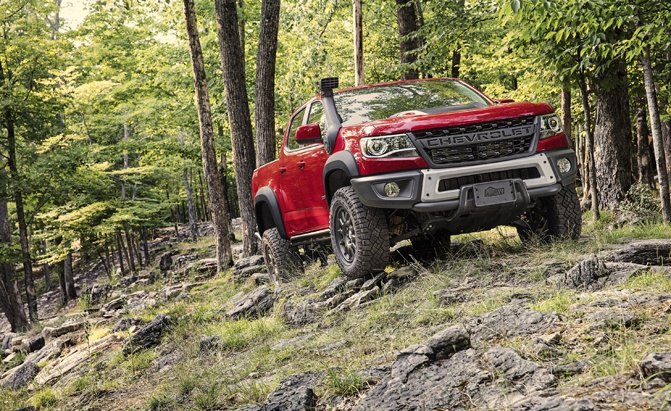
GMC Canyon: The GMC truck is aimed at the buyer who’d rather not bash over a bunch of rocks or blast through sand dunes as a weekend activity. There is an All-Terrain model, which is roughly analogous to the Z71. It, too, has a locking rear differential and an off-road tuned suspension. However, the brand is just as content to tout the All Terrain’s embossed headrests and contrasting red stitching on the seats. Adding the letter X to the All-Terrain model brings a t-case shield and knobbier tires.
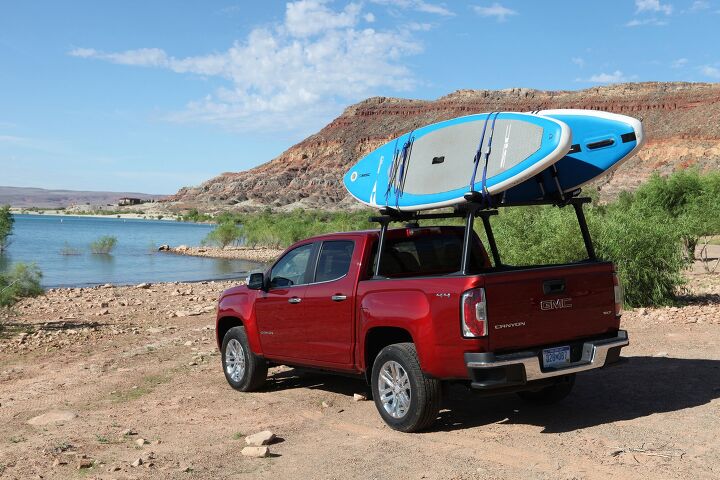
Bottom Line: Those who seek off-road fun are much better served to sample the Chevrolet side of your GM dealership. With its off-road prowess being offered in three different flavors (mild, hot, and extra hot) there is surely something to please your dirt palette.
ALSO SEE: Ford Ranger vs F-150: Which Truck is Right for You?
Technology
Chevrolet Colorado: This isn’t your grandfather’s mid-size Chevy truck. A large touchscreen is built into the center stack (no standing iPad-style displays here!), including the likes of Apple CarPlay and a backup camera. Chevy also offers built-in 4G LTE wifi to keep driver and passenger connected while they’re on the go. There is also a strong case to be made that the ZR2 trim is packed with technology underneath the truck, as those Multimatic DSSV dampers share much with track day Camaro coupes, not to mention having their roots in F1 racing and the Ford GT supercar.
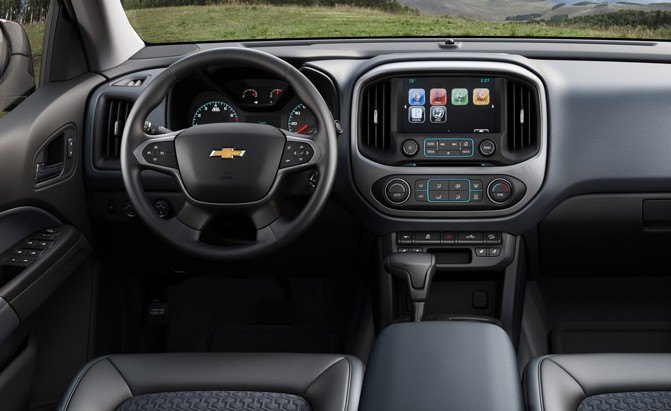
GMC Canyon: Driving aids like forward collision alert and lane departure warning systems are standard on Denali and available on lower trims. The collision alert helps warn drivers if the system detects a front-end collision situation is imminent while following a detected vehicle. Lane departure sounds an alert if the truck wanders from its lane without signaling while traveling at speeds faster than 35 mph.
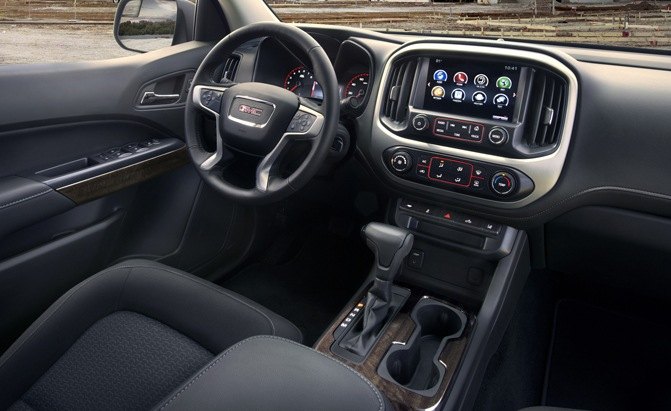
Bottom Line: Active safety nannies like the lane departure system are available on a single Chevy trim, the LT, while it is more widely offered on the GMC truck. If those features are important to you, the Canyon might be a better option.
Cabin Space & Cargo Capacity
Chevrolet Colorado: Both of these cousins are offered in three different body styles. Extended Cab models have a truck box measuring 6’2” in length, while Crew Cab shoppers have the selection of a 5’2” or 6’2” box. Naturally, since the Crew Cab has a larger passenger compartment, selecting that body style with the longer box makes for a truck that casts a big shadow. In fact, at 224.9 inches, such a machine is slightly lengthier than the brand’s jumbo Suburban. The larger box can logically accept more cargo.
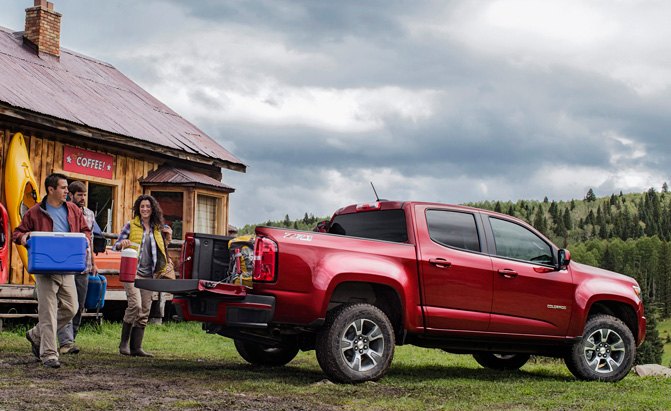
GMC Canyon: Interior dimensions for these trucks are identical, so the following numbers apply to the Chevy as well. Front seat riders will enjoy a healthy 41.4 inches of headroom, tapering to 36.7 inches and 38.2 inches in the rear for Extended and Crew Cab trucks respectively. Know that rear seat legroom isn’t great in either cab configuration, measuring just 35.8 inches for the larger Crew and a tiny 28.6 for the Extended Cab.
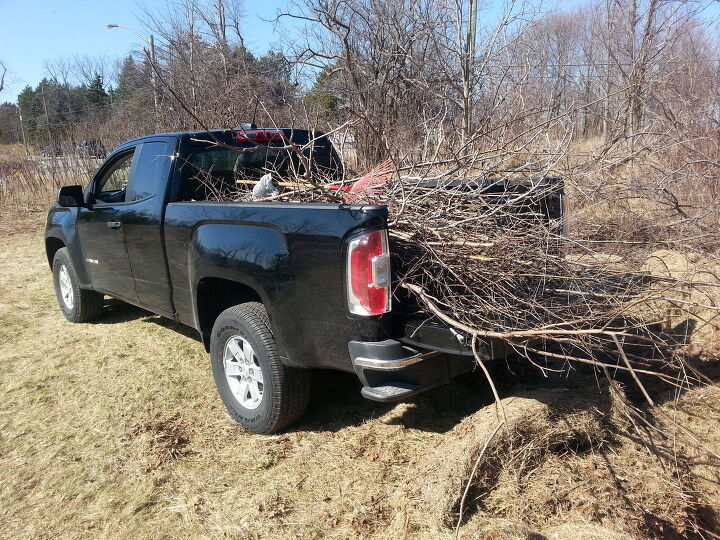
Bottom Line: From an interior size perspective, these two rigs are the same. Know that ZR2-trimmed Chevys are a bit higher off the ground, requiring a bit of an extra leap into the driver’s seat upon entry. It’s definitely not tall enough to warrant a rope ladder or anything for exiting, although one could make use of that model’s rock sliders to aid their descent.
Payload & Towing
Chevrolet Colorado: The brute of the group is the Colorado’s 2.8L turbodiesel, able to haul a maximum of 7,700 lbs when equipped with the proper kit. Go ahead and load up at the truck stop, as the same truck will also bear a payload of 1,496 pounds.

GMC Canyon: Shared with the Colorado, the 3.6L V6 engine is no slouch, either. It can tow up to 7,000 lbs when properly equipped and endure a maximum payload of 1,574 lbs. As always, don’t forget to take into account passengers and tongue weight when calculating how much you can put in the bed. Even the 200-hp four-banger can get the job done with tow and payload ratings of 3,500 lbs and 1,440 lbs, respectively, when optioned with the right gear.
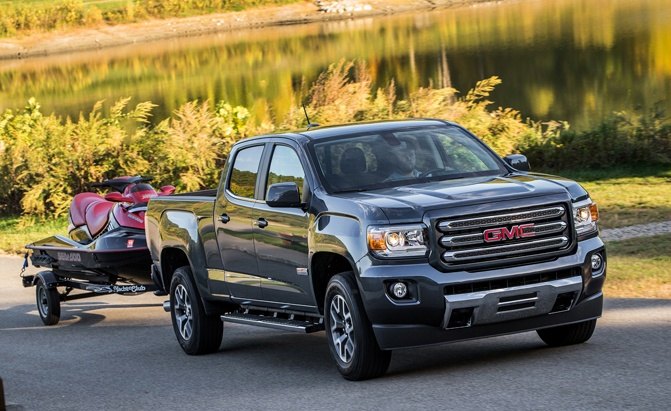
Bottom Line: Just because diesel engines are generally known as workhorses doesn’t mean the V6 gasoline option shouldn’t be considered even if you’re frequently towing something heavy. In fact, the gasser might be a better all-around option as your author has learned it is more flexible in day-to-day driving when unladen with the detritus of life.
Fuel Economy
Chevy Colorado: The diesel does, however, is rated significantly better in terms of fuel economy, particularly in two-wheel drive version. In fact, GM advertises that a diesel-equipped Colorado can stretch its legs to a maximum driving range of 630 miles. That works out to an alleged 30 mpg in highway driving, by the way. City driving? Well, that’s no better than the four-banger gasoline mill at 20 mpg for 2WD trucks. Adding 4×4 proffers a 2 mpg and 1 mpg in city and town respectively. Note that ZR2 models, with its addenda and off-road tires, is rated at 16/18 for the V6 and 18/22 for the diesel.
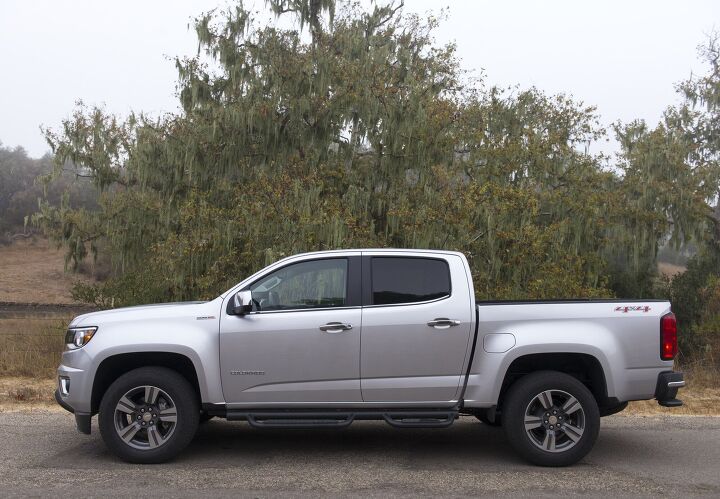
GMC Canyon: Seated in the cheap seats, a 2WD base four-banger should get 26 mpg on the highway, while the 2WD gas V6 is rated at 25 mpg. Give yourself a 2 mpg penalty for four-wheel drive. In the city, neither engine is likely to return more than 20 mpg. Note that gasoline 4WD versions get an identical highway economy of 24mpg regardless if the engine is a four- or six-cylinder.
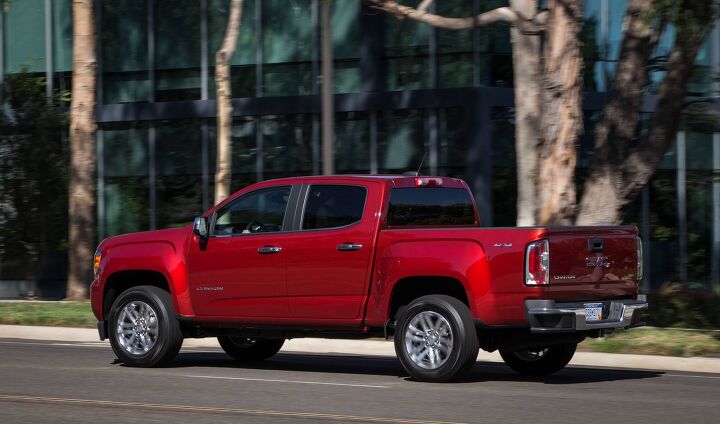
Bottom Line: Given that the two trucks share powertrains, fuel economy estimates for all three engines apply to both pickups. In town economy is shockingly similar across the board.
Style
Chevrolet Colorado: This blue-collar bowtie has the rugged good looks of someone who’s worked in construction their whole life but could’ve been a male model had life turned out just a little bit differently. Well, maybe a model at a local talent agency (a very local talent agency). But you get my point – there’s a handsomeness to this truck that is helped along by great proportions and a good selection of paint options. ZR2 and Bison trims ratchet up the visual drama with big tires and a mean stance. Your extroverted author prefers those, of course.
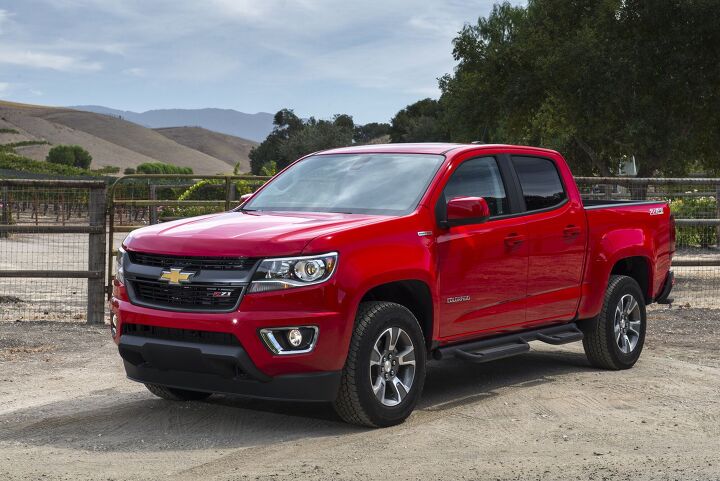
GMC Canyon: GMC has long billed itself as the truck to buy if you’re doing work during the day but then plan to shine the thing up for a night on the town. With its more upright styling choices, the Canyon ladles on the chrome in most trim levels, save for the All Terrain model which simply appears to be trying too hard, like the time your math teacher showed up in a hoodie and backwards ball cap. The high-zoot Denali, with its unique grille and exterior trim, looks sharp in a dark color.
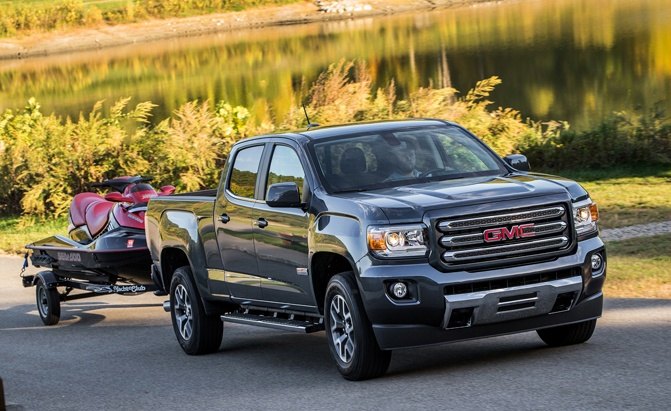
Bottom Line: It would be unfair to categorize the GMC as a bookworm while labeling the Chevy as the school loudmouth. However, those who buy the Canyon are probably more likely to make an informed opinion about a topic and then smartly keep it to themselves unless asked. Drivers of the Chevy will likely tell you exactly what they’re thinking, with ZR2 owners doing so very loudly.
Pricing
Chevy Colorado: The cheapest midsize bowtie truck available for 2019 is an extended cab four-pot with power going to the rear wheels for $22,395. Adding 4×4 to that particular truck jacks the sticker to $29,045, at which point one must take the Work Truck and not base trim. A mid-level LT with 4×4 and a Crew Cab costs $34,300. The macho ZR2 starts at $41,300 before topping out at $8,650 for a Bison-ized version
GMC Canyon: Perpetually pitched as the slightly fancier option to the mechanically identical Chevy, the GMC starts at $23,295 for a base 2WD extended cab truck in SL trim with the 2.5L four-cylinder engine. From there, base prices rise through a myriad of trims before reaching the V6-powered 4×4 Crew Cab long box Denali at a heady $45,295.
Bottom Line: Penny pinchers will favor the Chevy, particularly at volume trims like the LT, since it is reliably less expensive when compared to a similarly equipped GMC. If one is looking for a truck with slightly more visual appeal at the country club, a Denali in the mid-40s would be a solid choice out of these two trucks. However, at that price bracket, your author is headed straight for a Colorado ZR2.
The Verdict: Chevy Colorado vs GMC Canyon
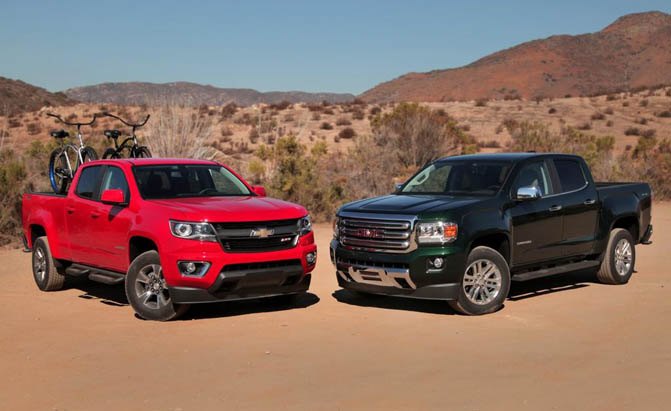
Both of these trucks pack a solid amount of capability into a reasonably-sized package, able to haul trailers and bear payload weights that were the domain of full-size pickups not too long ago. But how to choose? Well, look at your feet. If you’re wearing Dockers, get the GMC. If there are sneakers down there, pop for the Chevy. Chalk and cheese, indeed.
From AutoGuide.com
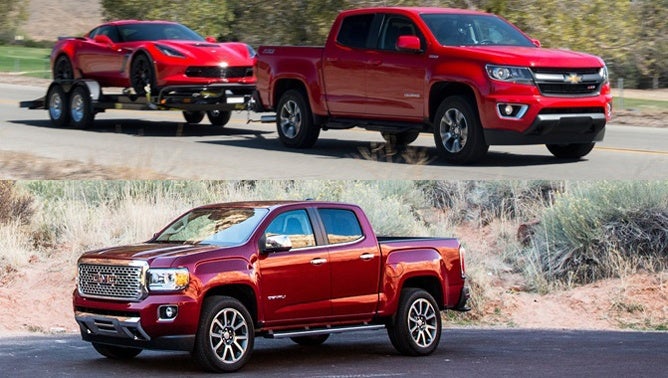
 Your Privacy Choices
Your Privacy Choices